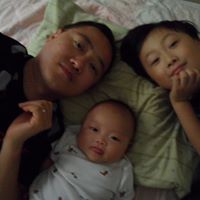Jung E Ryu
age ~55
from Yonkers, NY
- Also known as:
-
- Sarah Jung Eun Ryu
- Sarah Jungeun Ryu
- Jung E Kim
- Sarah J Ryu
Jung Ryu Phones & Addresses
- Yonkers, NY
- Falls Church, VA
- 302 Delmar Ct, North Wales, PA 19454
- Centreville, VA
- Norristown, PA
- Blue Bell, PA
- Jenkintown, PA
- Glenside, PA
- 104 Trotter Ln, North Wales, PA 19454 • 2156996966
Education
-
School / High School:University of Auckland
Ranks
-
Licence:New York - Currently registered
-
Date:2005
Us Patents
-
Design For Inter-Cell Interference Coordination In Mmwave Networks
view source -
US Patent:20220417952, Dec 29, 2022
-
Filed:Aug 31, 2022
-
Appl. No.:17/823919
-
Inventors:- San Diego CA, US
Junyi LI - Fairless Hills PA, US
Jung Ho RYU - Fort Lee NJ, US
Vasanthan RAGHAVAN - West Windsor Township NJ, US -
International Classification:H04W 72/12
H04W 24/10
H04W 72/04
H04L 5/00
H04B 17/336
H04B 7/06
H04W 56/00
H04B 17/318 -
Abstract:A configuration for inter-cell interference coordination in wireless communication systems. The apparatus determines a priority order of a first base station to schedule a first transmission with a first UE. The apparatus transmits a first transmission request to the first UE to schedule the first transmission. The apparatus receives, from the first UE, a measurement report based on the first transmission request received by the first UE, the measurement report indicates a signal quality of the first transmission request. The apparatus determines to schedule the first transmission with the first UE based at least on the measurement report. The apparatus sends a schedule indication to at least a second base station indicating whether the first transmission is scheduled with the first UE, at least the second base station has a lower priority order than the first base station.
-
Signaling For Multi-Panel Ue Activation
view source -
US Patent:20220369230, Nov 17, 2022
-
Filed:Jul 26, 2022
-
Appl. No.:17/815077
-
Inventors:- San Diego CA, US
Jung Ho Ryu - Fort Lee NJ, US
Tianyang Bai - Bridgewater NJ, US
Yan Zhou - San Diego CA, US
Junyi Li - Chester NJ, US
Tao Luo - San Diego CA, US -
International Classification:H04W 52/02
H04W 72/14 -
Abstract:The present disclosure provides signaling for multi-panel user equipment (MPUE) activation. The MPUE may have at least an active first panel and an inactive second panel. The MPUE may determine to activate the second panel. The MPUE may activate the second panel in response to the determination. The MPUE may transmit, from the active first panel to a base station, a status indicating that the second panel is active. The MPUE may transmit, after an activation time, an uplink transmission from the second panel to the base station.
-
Techniques For Uplink Power Control
view source -
US Patent:20230086946, Mar 23, 2023
-
Filed:Sep 20, 2021
-
Appl. No.:17/480020
-
Inventors:- San Diego CA, US
Junyi Li - Fairless Hills PA, US
Yan Zhou - San Diego CA, US
Jung Ho Ryu - Fort Lee NJ, US
Tianyang Bai - Somerville NJ, US
Navid Abedini - Basking Ridge NJ, US
Kiran Venugopal - Raritan NJ, US
Tao Luo - San Diego CA, US -
International Classification:H04W 52/14
H04W 72/04 -
Abstract:Methods, systems, and devices for wireless communications are described. A base station may indicate to a UE a first set of uplink power control parameters associated with half-duplex communications and a second set of uplink power control parameters associated with full-duplex communications. Alternatively, the base station may indicate the first set of uplink power control parameters and a set of power offsets associated with full-duplex communications. The base station may indicate a first set of resources associated with the first set of uplink power control parameters and a second set of resources associated with the second set of uplink power control parameters or the set of power offsets. In response, the UE may transmit one or more uplink messages over one or more resources of the second set of resources in accordance with the second set of uplink power control parameters or the set of power offsets.
-
Techniques For Autonomously Determining Candidate Beams To Support Full-Duplex Communication
view source -
US Patent:20210376905, Dec 2, 2021
-
Filed:May 11, 2021
-
Appl. No.:17/317694
-
Inventors:- San Diego CA, US
Jung Ho RYU - Fort Lee NJ, US
Qian ZHANG - Basking Ridge NJ, US
Navid ABEDINI - Basking Ridge NJ, US
Tao LUO - San Diego CA, US -
International Classification:H04B 7/06
H04W 24/10
H04L 5/14
H04W 72/04 -
Abstract:Aspects described herein relate to autonomously measuring one or more new candidate beam pairs during configured resources to determine measurement results for the one or more new candidate beam pairs, where the configured resources can be configured for uplink communications or measurement gaps for transmitting signals to measure candidate beams. A measurement result or an indication of at least one new candidate beam pair can be reported based on a measurement result for the at least one new candidate beam pair of the one or more new candidate beam pairs.
-
Recovery Mechanism For Secondary Cell
view source -
US Patent:20210351836, Nov 11, 2021
-
Filed:May 21, 2021
-
Appl. No.:17/327094
-
Inventors:- San Diego CA, US
Jung Ho RYU - Fort Lee NJ, US
Makesh Pravin JOHN WILSON - San Diego CA, US
Tao LUO - San Diego CA, US -
International Classification:H04B 7/08
H04W 76/19
H04W 24/10
H04W 36/06
H04W 36/30
H04W 36/36
H04W 48/12
H04W 72/04
H04W 72/08 -
Abstract:Aspects of the present disclosure relate to wireless communications, and more particularly, to cell recovery techniques. One example method generally includes receiving, at a user-equipment (UE), at least one pilot signal via a secondary cell, receive, via a primary cell, a first message triggering reporting of at least one preferred beam for communication via the secondary cell, determining the preferred beam based on the at least one pilot signal, transmitting, via the primary cell, a report indicating the at least one preferred beam, and communicating data via the secondary cell and via the preferred beam.
-
Methods For Beam Management In Millimeter Wave Relays
view source -
US Patent:20210212051, Jul 8, 2021
-
Filed:Jan 3, 2020
-
Appl. No.:16/733861
-
Inventors:- San Diego CA, US
Jung Ho Ryu - Fort Lee NJ, US
Tianyang Bai - Bridgewater NJ, US
Hua Wang - Basking Ridge NJ, US
Junyi Li - Chester NJ, US -
International Classification:H04W 72/04
H04W 16/28
H04B 7/06
H04W 8/00
H04W 76/14 -
Abstract:Methods, systems, and devices for wireless communications are described. A user equipment (UE) may receive configuration information from a base station that indicates a set of resources for the UE to establish sidelink communications with another UE in a wireless network. The UE may transmit a first set of reference signals using a first set of beams to determine a set of neighboring candidate UEs for a sidelink connection. The UE may then transmit a second set of reference signals on a second set of beams to the neighboring candidate UEs, and may select a second UE located in the determined neighboring set using various beam scanning procedures. The UE may identify a transmit beam associated with the second UE, and may establish the sidelink connection using the identified transmit beam.
-
Inter-Beam Phase Factor Tracking
view source -
US Patent:20210159947, May 27, 2021
-
Filed:Nov 19, 2020
-
Appl. No.:16/949904
-
Inventors:- San Diego CA, US
Jung Ho RYU - Fort Lee NJ, US
Junyi LI - Chester NJ, US -
International Classification:H04B 7/0408
H04W 72/04
H04L 5/00
H04B 7/08 -
Abstract:Various aspects of the present disclosure generally relate to wireless communication. In some aspects, a wireless communication device may receive, from a base station (BS), an indication of an inter-beam phase factor tracking reference signal configuration for inter-beam phase factor tracking, wherein at least one of the wireless communication device or the BS performs multi-beam combining over at least two static directions or beams from one or more antenna panels. The wireless communication device may perform one or more measurements of an inter-beam phase factor tracking reference signal based at least in part on the inter-beam phase factor tracking reference signal configuration. Numerous other aspects are provided.
-
Methods And Apparatus For Beam Training
view source -
US Patent:20210159957, May 27, 2021
-
Filed:Nov 19, 2020
-
Appl. No.:16/953199
-
Inventors:- San Diego CA, US
Jung Ho RYU - Fort Lee NJ, US
Kapil GULATI - Belle Mead NJ, US
Tianyang BAI - Somerville NJ, US
Junyi LI - Chester NJ, US -
International Classification:H04B 7/06
H04W 76/14
H04L 5/00 -
Abstract:Aspects of the present disclosure include methods, apparatuses, and computer readable media for establishing a communication link with a second UE, transmitting first information associated with first beam configurations of the first UE to the second UE, receiving second information associated with second beam configurations of the second UE from the second UE, and performing a beam training process by transmitting a number of reference signals to the second UE, wherein the number is derived from the first information associated with the first beam configurations and the second information associated with the second beam configurations.
Lawyers & Attorneys

Jung Ryu - Lawyer
view sourceAddress:
1068132220 (Office)
Licenses:
New York - Currently registered 2005
Education:
University of Auckland
Resumes

Jung Ryu
view source
Jung Ryu
view source
Jung Ryu
view sourceLocation:
United States
Flickr
Youtube
Classmates

Jung Ryu, East High Schoo...
view source
Kwi Jung Ryu | North Shor...
view source
Mi Jung Ryu
view sourceFriends:
Jason Park, Haa Woo, Mi Jung Ryu. Photo Log in to contact Mi Jung Ryu.
Mi Jung Ryu. Photo Log in to contact Mi Jung Ryu.

Jung Ryu W
view sourceJung Ryu Won

Jung Hwa Ryu
view source
Jung Ryu
view source
Jung Ryu
view source
Hyun Jung Ryu
view source
Pamela Jung Ryu W
view source
Jung Hyun Ryu
view sourceGoogleplus

Jung Ryu
Education:
California Polytechnic State University - Management Information System

Jung Ryu

Jung Ryu

Jung Ryu

Jung Ryu
Myspace
Get Report for Jung E Ryu from Yonkers, NY, age ~55















